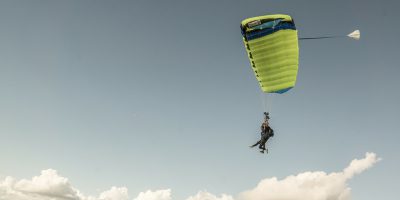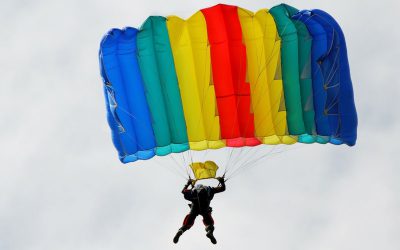Whether it’s your first jump or you’re a seasoned pro, the skydiving landing pattern is one of the most important parts of your skydive. After all, the ground is literally the hardest part. So it’s crucial to know how to execute a correct landing pattern. Following the rules for landing patterns not only allows skydivers to touchdown safely but also helps avoid any collisions with other skydivers in the area.
So, how do you land when skydiving? A skydiving landing pattern is actually just like an airplane landing pattern, only smaller. An aircraft landing pattern is made up of a few different landing pattern legs that allow the pilot to navigate the landing safely and consistently.
Learning how to land is often the most stressful aspect of skydiving for newer solo jumpers. But landing patterns aren’t actually that complicated! Take a look at the different steps to landing a parachute and decide for yourself!
Landing Pattern Basics
 There are certain aspects of landing patterns that rarely change, regardless of conditions. Every good landing pattern is flown in the same shape and at the same altitudes. This way, each and every time a skydiver lands, they have a very clear plan for how to get to the ground. It also makes it easier for other jumpers to predict what the air traffic around them will be doing!
There are certain aspects of landing patterns that rarely change, regardless of conditions. Every good landing pattern is flown in the same shape and at the same altitudes. This way, each and every time a skydiver lands, they have a very clear plan for how to get to the ground. It also makes it easier for other jumpers to predict what the air traffic around them will be doing!
The ideal shape for a landing pattern is an open rectangle. This rectangle is made up of three sides, or “legs” – downwind, base, and final. Each of these legs starts at a predetermined altitude.
And what are the landing pattern altitudes for skydiving? For the most part, the three big altitudes to remember are 1,000 feet, 600 feet, and 300 feet. Skydivers enter their landing pattern on the downwind leg at 1,000 feet, turn onto the base leg at 600 feet, and then onto the final approach at 300 feet. These altitudes can sometimes fluctuate a hundred or so feet, but for the most part, this is the template all skydivers adhere to. We’ll get deeper into these legs in a moment.
In the meantime, you may be wondering, “how hard is the landing when skydiving?” If done correctly, landing from a jump should be just about as soft as hopping down from a chair. The landing pattern technique sets jumpers up to be able to land a parachute in the best possible conditions for comfortable touchdowns! (Isn’t technology and training amazing?!)
Downwind Leg
The first leg of any landing pattern is called the downwind leg. It’s referred to as the downwind leg because the jumper is doing just that – flying downwind! This leg is the entry point into the landing pattern and starts around 1,000 feet. A successful landing pattern begins upwind and is slightly offset from the landing target. It’s a lot harder to fly into the wind and fight to get to where you want to land than it is to have the wind at your back pushing you there!
Because the wind is pushing the skydiver from behind, the downwind leg is typically the longest of the three legs. And the windier it is, the longer this leg will be. It’s important to consider the wind speed when calculating where to start the downwind leg because the position of every other part of the landing pattern is dependent on this first leg!
Base Leg
At 600 feet, the skydiver will make a 90-degree turn onto what’s known as the base leg. The base leg is the only leg that flies perpendicular to the wind. This makes the base leg a little more difficult to navigate.
The wind hitting the jumper in the side causes them to fly slightly off course, a type of flight that’s known as crabbing. (Guess where that term came from? Hint: crabs walk sideways.) While flying the base leg, skydivers have to actively correct this sideways push from the wind to make sure they stay on track to land on the target.
Final Approach
 At 300 feet, it’s go time. Once the skydiver finishes the base leg and is in line with the target, it’s time to make one last 90-degree turn into the wind. This leg is where things get serious. Skydivers try to fly their final approach as straight as possible and use this time to prepare their bodies for landing. There’s a lot skydivers-in-training and licensed flyers have to think about when flying a landing pattern, especially on the final approach.
At 300 feet, it’s go time. Once the skydiver finishes the base leg and is in line with the target, it’s time to make one last 90-degree turn into the wind. This leg is where things get serious. Skydivers try to fly their final approach as straight as possible and use this time to prepare their bodies for landing. There’s a lot skydivers-in-training and licensed flyers have to think about when flying a landing pattern, especially on the final approach.
What Are The Landing Priorities In Skydiving?
There are three main priorities instructors and solo skydivers must keep in mind at all times, especially when on the final approach.
Priority 1: Wing straight and level.
When a parachute is turning, it dives and increases speed. This means that if a parachute is turned at too low an altitude, it will dive straight into the ground. If this is the only priority a skydiver can manage, it’s definitely the most important one.
Priority 2: Avoid obstacles.
The higher a skydiver can identify an obstacle (trees, water, a building), the easier it will be to avoid. A small degree of correction at 250 feet creates a complete change of course over the ground. Identify and avoid obstacles early!
Priority 3: Flare to at least half breaks.
A parachute flies at a forward speed of about 20 mph. We don’t know about you, but we’re lucky to hit 20 mph on a bicycle, let alone while running! Flaring the parachute at least halfway allows the skydiver to slow down enough to land safely.
Landing into the wind isn’t a priority, but it’s certainly preferred! Flying into the wind slows the speed of the parachute down a bit and makes landings softer.
Are you ready to touchdown at Skydive Monroe? Book a tandem skydive and leave the landing pattern to the professionals, or learn to skydive solo and land right on target! Blue skies!
Copyright © 2024, Skydive Monroe, All Rights Reserved.
DropZone Web Design & Marketing by Beyond Marketing, LLC



